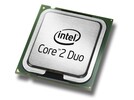Intel Core 2 Duo T9600 vs Intel Core 2 Duo T9550
Intel Core 2 Duo T9600
► remove from comparison
Die Intel Core 2 Duo T9600 Dual-Core CPU ist ein High-End Dual-Core Prozessor für Notebooks. Die Architektur des Prozessors basiert auf den Penryn Kern und wird in 45nm gefertigt. Im Vergleich zum schnelleren T9900 unterstützt er jedoch noch nicht den C1E State. Der neuere Core 2 Duo P9700 bietet die selben Leistungsdaten, jedoch bei deutlich geringerem Stromverbrauch (28 W versus 35 Watt TDP).
Dank der relativ hohen Taktung von 2.8 GHz, ist die Performance für die alle Spiele in 2009 ausreichend (nur GTA 4 profitiert deutlich von mehr Prozessorkernen). Die alten Core 2 Quad Mobilprozessoren (Q9000, QX9300) werden dank der hohen Taktung bei den meisten Spielen geschlagen (da Spiele aus 2009 meist nicht mehr als 2 Kerne auslasten).
Der Penryn (Montevina Update) Kern bietet 2 Integer Units, 1 Floating Point Unit, 1 Load Unit und 1 Store Unit in einer 14-stufigen Pipeline. Mit der Wide Dynamic Execution Technologie kann der Kern bis zu vier volle Instruktionen gleichzeitig ausführen.
Dank Dynamic Acceleration (später Turbo Modus genannt), kann sich ein Kern um eine Stufe übertakten, wenn der zweite im Idle Modus (Leerlauf) ist.
Das integrierte Enhanced Speedstep kann die Taktfrequenz des Prozessors dynamisch an die Leistungsanforderungen anpassen. Dadurch läuft die CPU ohne Last nur mit 800 MHz.
Der Core 2 Duo T9900 passt in den Socket P (mit 479 Pins):
Socket P / Micro Flip-Chip Pin Grid Array (Micro-FCPGA) requires 479-pin surface mount Zero Insertion Force (ZIF) socket (mPGA479M socket) or Micro Flip-Chip Ball Grid Array (Micro-FCBGA) for surface mount (479-ball)
Intel Core 2 Duo T9550
► remove from comparison
Die Intel Core 2 Duo T9550 Dual-Core CPU ist ein oberer Mittelklasse Dual-Core Prozessor für Notebooks. Die Architektur des Prozessors basiert auf den Penryn Kern und wird in 45nm gefertigt. Der T9550 ist vergleichbar mit dem teureren P9600, welcher jedoch auf einen TDP von 25 Watt spezifiziert ist (T9550 max. 35 Watt TDP).
Dank der 2.66 GHz und des großen Level 2 Cache von 6 MB (shared für alle beiden Kerne), ist die Anwendungsleistung für Single-Threaded Anwendungen und Spiele welche hauptsächlich einen Kern benutzen, sehr gut. Moderne Spiele, welche mehrere Threads benutzen, können jedoch von einem 4-Kerner deutlich mehr profitieren (z.B. ein Drittel mehr Leistung bei DIRT 2 beim Einsatz von 4 Kernen, siehe unseren Prozessorleistung und Spiele Artikel). In 2009 reichte die Performance des T9550 jedoch für eine flüssige Darstellung von allen Spielen (GTA4 ev. knapp) und auch anspruchsvolle Anwendungen kommen mit der Leistung gut aus.
Der Penryn (Montevina Update) Kern bietet 2 Integer Units, 1 Floating Point Unit, 1 Load Unit und 1 Store Unit in einer 14-stufigen Pipeline. Mit der Wide Dynamic Execution Technologie kann der Kern bis zu vier volle Instruktionen gleichzeitig ausführen.
Im Core 2 Duo T9550 wurden keine Features der Penryn Architektur deaktiviert. Daher unterstützt er 64 Bit, Virtualisierung und alle Stromsparfunktionen (z.B. C6 State).
Dank Dynamic Acceleration (später Turbo Modus genannt), kann sich ein Kern um eine Stufe übertakten, wenn der zweite im Idle Modus (Leerlauf) ist.
Das integrierte Enhanced Speedstep kann die Taktfrequenz des Prozessors dynamisch an die Leistungsanforderungen anpassen. Dadurch läuft die CPU ohne Last nur mit 800 MHz.
Der Core 2 Duo T9550 passt in den Socket P (BGA479, PGA478).
| Model | Intel Core 2 Duo T9600 | Intel Core 2 Duo T9550 |
| Codename | Penryn | Penryn |
| Series | Intel Core 2 Duo | Intel Core 2 Duo |
| Serie: Core 2 Duo Penryn | ||
| Clock | 2800 MHz | 2660 MHz |
| FSB | 1066 | 1066 |
| L2 Cache | 6 MB | 6 MB |
| Cores / Threads | 2 / 2 | 2 / 2 |
| TDP | 35 Watt | 35 Watt |
| Transistors | 410 Million | 410 Million |
| Technology | 45 nm | 45 nm |
| Voltage | 1.05-1.2125 V V | 1.05-1.212V V |
| Die Size | 107 mm2 | 107 mm2 |
| max. Temp. | 105 °C | 105 °C |
| Socket | Socket P (BGA479, PGA478) | BGA479, PGA478 |
| Architecture | x86 | x86 |
| $316 U.S. | $316 U.S. | |
| Announced | ||
| Manufacturer | ark.intel.com | ark.intel.com |
| L1 Cache | 128 KB | |
| Features | Virtualization, Trusted Execution, Intel 64, Enhanced Speedstep (up to C6), ExBit, SSE4.1 |
Benchmarks
Average Benchmarks Intel Core 2 Duo T9600 → 100% n=13
Average Benchmarks Intel Core 2 Duo T9550 → 94% n=13
* Smaller numbers mean a higher performance
1 This benchmark is not used for the average calculation












